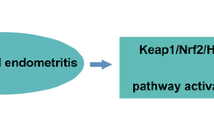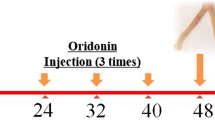Abstract
Catalpol is the main active ingredient of an extract from Radix rehmanniae, which in a previous study showed a protective effect against various types of tissue injury. However, a protective effect of catalpol on uterine inflammation has not been reported. In this study, to investigate the protective mechanism of catalpol on lipopolysaccharide (LPS)-induced bovine endometrial epithelial cells (bEECs) and mouse endometritis, in vitro and in vivo inflammation models were established. The Toll-like receptor 4 (TLR4)/nuclear factor-κB (NF-κB) signaling pathway and its downstream inflammatory factors were detected by enzyme-linked immunosorbent assay (ELISA), quantitative real-time polymerase chain reaction (qRT-PCR), western blot (WB), and immunofluorescence techniques. The results from ELISA and qRT-PCR showed that catalpol dose-dependently reduced the expression of pro-inflammatory cytokines such as tumor necrosis factor α (TNF-α), interleukin (IL)-1β, and IL-6, and chemokines such as C-X-C motif chemokine ligand 8 (CXCL8) and CXCL5, both in bEECs and in uterine tissue. From the experimental results of WB, qRT-PCR, and immunofluorescence, the expression of TLR4 and the phosphorylation of NF-κB p65 were markedly inhibited by catalpol compared with the LPS group. The inflammatory damage to the mouse uterus caused by LPS was greatly reduced and was accompanied by a decline in myeloperoxidase (MPO) activity. The results of this study suggest that catalpol can exert an anti-inflammatory impact on LPS-induced bEECs and mouse endometritis by inhibiting inflammation and activation of the TLR4/NF-κB signaling pathway.
概要
目 的
研究和探讨梓醇对脂多糖 (LPS)诱导的牛子宫内膜上皮细胞和小鼠子宫内膜炎的保护机制。
创新点
首次证明梓醇对 LPS 刺激的牛子宫内膜上皮细胞炎症和 LPS 诱导的小鼠子宫内膜炎具有保护作用, 其保护机制与抑制 Toll 样受体 4/核因子 κB (TLR4/NF-κB) 炎症信号通路有关。
方 法
通过 LPS 的诱导, 分别建立牛子宫内膜上皮细胞体外炎症模型和小鼠子宫内膜体内炎症模型, 设置不同梓醇作用浓度梯度, 采用酶联免疫吸附测定法 (ELISA)、 实时荧光定量聚合酶链式反应 (qRT0PCR)、 蛋白免疫印迹 (western blot) 和免疫荧光技术检测 TLR4/NF-κB 信号通路及其下游炎症因子的表达。
结 论
梓醇可以显著抑制 TLR4 和 p65 NF-κB 信号通路的表达, 降低炎性因子肿瘤坏死因子 α (TNF-α)、 白细胞介素 1β (IL-1β) 和白细胞介素 6 (IL-6) 的水平以及趋化因子 CXCL8 和 CXCL5 的表达, 同时降低子宫组织髓过氧化物酶水平。 通过在体内外炎症模型中加入梓醇, 可以显著降低牛子宫内膜上皮细胞的炎症反应, 有效保护小鼠体内子宫内膜的组织损伤。
Similar content being viewed by others
Change history
21 December 2019
The original version of this article unfortunately contained a mistake. In p.823, Figs. 8c and 8d were incorrect, and the obvious pathological changes were mistakenly placed in the picture. The correct versions should be as follows:
References
Angrisano T, Pero R, Peluso S, et al., 2010. LPS-induced IL-8 activation in human intestinal epithelial cells is accompanied by specific histone H3 acetylation and methylation changes. BMC Microbiol, 10:172. https://doi.org/10.1186/1471-2180-10-172
Begley LA, Kasina S, Mehra R, et al., 2008. CXCL5 promotes prostate cancer progression. Neoplasia, 10(3):244–254. https://doi.org/10.1593/neo.07976
Brodzki P, Kostro K, Brodzki A, et al., 2015. Inflammatory cytokines and acute-phase proteins concentrations in the peripheral blood and uterus of cows that developed endometritis during early postpartum. Theriogenology, 84(1): 11–18. https://doi.org/10.1016/j.theriogenology.2015.02.006
Brown K, Park S, Kanno T, et al., 1993. Mutual regulation of the transcriptional activator NF-KB and its inhibitor, IκBα. Proc Natl Acad Sci USA, 90(6):2532–2536. https://doi.org/10.1073/pnas.90.6.2532
Chen BY, Jiang LX, Hao K, et al., 2018. Protection of plasma transfusion against lipopolysaccharide/D-galactosamine-induced fulminant hepatic failure through inhibiting apoptosis of hepatic cells in mice. J Zhejiang Univ-Sci B (Biomed & Biotechnol), 19(6):436–444. https://doi.org/10.1631/jzus.B1700277
Chen Z, Deng S, Yuan DC, et al., 2018. Novel nano-microspheres containing chitosan, hyaluronic acid, and chondroitin sulfate deliver growth and differentiation factor-5 plasmid for osteoarthritis gene therapy. J Zhejiang Univ-Sci B (Biomed & Biotechnol), 19(12): 910–923. https://doi.org/10.1631/jzus.B1800095
Chensue SW, 2001. Molecular machinations: chemokine signals in host-pathogen interactions. Clin Microbiol Rev, 14(4): 821–835. https://doi.org/10.1128/CMR.14.4.821-835.2001
de Vries MA, Klop B, Eskes SA, et al, 2014. The postprandial situation as a pro-inflammatory condition. Clin Investig Arterioscler, 26(4): 184–192. https://doi.org/10.1016/j.arteri.2014.02.007
Feng XN, Zhang DF, Li XY, et al., 2018. CXCL5, the upregulated chemokine in patients with uterine cervix cancer, in vivo and in vitro contributes to oncogenic potential of Hela uterine cervix cancer cells. Biomed Pharmacother, 107:1496–1504. https://doi.org/10.1016/j.biopha.2018.08.149
Guo S, Jiang KF, Wu HC, et al., 2018. Magnoflorine ameliorates lipopolysaccharide-induced acute lung injury via suppressing NF-κB and MAPK activation. Front Pharmacol, 9:982. https://doi.org/10.3389/fphar.2018.00982
Haas M, Kaup FJ, Neumann S, 2016. Canine pyometra: a model for the analysis of serum CXCL8 in inflammation. J Vet Med Sci, 78(3):375–381. https://doi.org/10.1292/jvms.15-0415
Herath S, Lilly ST, Santos NR, et al, 2009. Expression of genes associated with immunity in the endometrium of cattle with disparate postpartum uterine disease and fertility. Reprod Biol Endocrinol, 7:55. https://doi.org/10.1186/1477-7827-7-55
Huang CL, Cui YL, Ji LL, et al., 2013. Catalpol decreases peroxynitrite formation and consequently exerts cardioprotective effects against ischemia/reperfusion insult. Pharm Biol, 51(4):463–473. https://doi.org/10.3109/13880209.2012.740052
Israël A, 2010. The IKK complex, a central regulator of NF-κB activation. Cold Spring Harb Perspect Biol, 2(3):a000158. https://doi.org/10.1101/cshperspect.a000158
Jiang KF, Chen XY, Zhao G, et al., 2017. IFN-x plays an anti-inflammatory role in Staphylococcus aureus-induced endometritis in mice through the suppression of NF-κB pathway and MMP9 expression. J Interferon Cytokine Res, 37(2):81–89. https://doi.org/10.1089/jir.2016.0058
Karlsson I, Hagman R, Guo YZ, et al., 2015. Pathogenic Escherichia coli and lipopolysaccharide enhance the expression of IL-8, CXCL5, and CXCL10 in canine endometrial stromal cells. Theriogenology, 84(1): 34–42. https://doi.org/10.1016/j.theriogenology.2015.02.008
Kawamura M, Toiyama Y, Tanaka K, et al., 2012. CXCL5, a promoter of cell proliferation, migration and invasion, is a novel serum prognostic marker in patients with colorectal cancer. Eur J Cancer, 48(14):2244–2251. https://doi.org/10.1016/j.ejca.2011.11.032
Koyama T, Omori R, Koyama K, et al., 2018. Optimization of diagnostic methods and criteria of endometritis for various postpartum days to evaluate infertility in dairy cows. Theriogenology, 119:225–232. https://doi.org/10.1016/j.theriogenology.2018.07.002
Li QT, Verma IM, 2002. NF-κB regulation in the immune system. Nat Rev Immunol, 2(10): 725–734. https://doi.org/10.1038/nri910
Liu J, He QJ, Zou W, et al., 2006. Catalpol increases hippocampal neuroplasticity and up-regulates PKC and BDNF in the aged rats. Brain Res, 1123(1):68–79. https://doi.org/10.1016/j.brainres.2006.09.058
Lyu A, Chen JJ, Wang HC, et al., 2017. Punicalagin protects bovine endometrial epithelial cells against lipopolysaccharide-induced inflammatory injury. J Zhejiang Univ-Sci B (Biomed & Biotechnol), 18(6):481–491. https://doi.org/10.1631/jzus.B1600224
Machado Pfeifer LF, de Souza Andrade J, Moreira EM, et al., 2018. Uterine inflammation and fertility of beef cows subjected to timed AI at different days postpartum. Anim Reprod Sci, 197:26–277. https://doi.org/10.1016/j.anireprosci.2018.08.039
Nicholas C, Batra S, Vargo MA, et al., 2007. Apigenin blocks lipopolysaccharide-induced lethality in vivo and proinflammatory cytokines expression by inactivating NF-KB through the suppression of p65 phosphorylation. J Immunol, 179(10):7121–7127. https://doi.org/10.4049/jimmunol.179.10.7121
Sheldon IM, Williams EJ, Miller ANA, et al., 2008. Uterine diseases in cattle after parturition. Vet J, 176(1):115–121. https://doi.org/10.1016/j.tvjl.2007.12.031
Shen Y, Liu B, Mao W, et al, 2018. PGE2 downregulates LPS-induced inflammatory responses via the TLR4-NF-KB signaling pathway in bovine endometrial epithelial cells. Prostaglandins LeukotEssent Fatty Acids, 129:25–31. https://doi.org/10.1016/j.plefa.2018.01.004
Sicsic R, Goshen T, Dutta R, et al., 2018. Microbial communities and inflammatory response in the endometrium differ between normal and metritic dairy cows at 5–10 days post-partum. Vet Res, 49:77. https://doi.org/10.1186/sl3567-018-0570-6
Socha BM, Lada P, et al., 2018. The influence of experimentally induced endometritis on the PPAR expression profile in the bovine endometrium. Theriogenology, 122: 74–83. https://doi.org/10.1016/j.theriogenology.2018.09.013
Turner ML, Cronin JG, et al., 2014. Epithelial and stromal cells of bovine endometrium have roles in innate immunity and initiate inflammatory responses to bacterial lipopeptides in vitro via Toll-like receptors TLR2, TLR1, and TLR6. Endocrinology, 155(4): 1453–1465. https://doi.org/10.1210/en.2013-1822
van Schyndel SJ, Pascottini OB, et al., 2018. Comparison of cow-side diagnostic techniques for subclinical endometritis in dairy cows. Theriogenology, 120:117–122. https://doi.org/10.1016/j.theriogenology.2018.08.001
Wagener K, Gabler C, Drillich M, 2017. A review of the ongoing discussion about definition, diagnosis and pathomecha-nism of subclinical endometritis in dairy cows. Theriogenology, 94:21–30. https://doi.org/10.1016/j.theriogenology.2017.02.005
Wang J, Yan XX, Nesengani LT, et al, 2018. LPS-induces IL-6 and IL-8 gene expression in bovine endometrial cells “through DNA methylation”. Gene, 677:266–272. https://doi.org/10.1016/j.gene.2018.07.074
Wu HC, Zhao G, Jiang KF, et al., 2016. IFN-τ alleviates lipopolysaccharide-induced inflammation by suppressing NF-κB and MAPKs pathway activation in mice. Inflammation, 39(3): 1141–1150. https://doi.org/10.1007/sl0753-016-0348-9
Yang C, Liu P, Wang S, et al., 2018. Shikonin exerts antiinflammatory effects in LPS-induced mastitis by inhibiting NF-KB signaling pathway. Biochem Biophys Res Commun, 505(1): 1–6. https://doi.org/10.1016/j.bbrc.2018.08.198
Ye GY, Wang KY, Gui QD, et al., 2018. Ureaplasma urealyticum-derived lipid-associated membrane proteins introduce IL-6, IL-8, and TNF-α cytokines into human amniotic epithelial cells via Toll-like receptor 2}. J Zhejiang Univ-Sci B (Biomed & Biotechnol), 19(8):654–661. https://doi.org/10.1631/jzus.B1800005
Zhang AH, Hao S, Bi J, et al., 2009. Effects of catalpol on mitochondrial function and working memory in mice after lipopolysaccharide-induced acute systemic inflammation. Exp Toxicol Pathol, 61(5):461–469. https://doi.org/10.1016/j.etp.2008.10.010
Zhang XL, Liu WD, Niu XH, et al, 2010. Systemic administration of catalpol prevents D-galactose induced mitochondrial dysfunction in mice. Neurosci Lett, 473(3):224–228. https://doi.org/10.1016/j.neulet.2010.02.054
Zhao G, Zhang T, Wu HC, et al, 2019. MicroRNA let-7c improves LPS-induced outcomes of endometritis by suppressing NF-κB signaling. Inflammation, 42(2):650–657. https://doi.org/10.1007/sl0753-018-0922-4
Author information
Authors and Affiliations
Contributions
Hua ZHANG and Zhi-min WU designed and performed this study. Ya-ping YANG, Jing YANG, and Ying-fang GUO assisted in carrying out the research. Aftab SHAUKAT assisted in editing language. Tao ZHANG, Xin-ying ZHU, and Jin-xia QIU assisted in analyzing the data. Gan-zhen DENG and Dong-mei SHI proofread the manuscript. All authors have approved the final manuscript. Therefore, all authors have full access to all the data in the study and take responsibility for the integrity and security of the data.
Corresponding authors
Ethics declarations
Hua ZHANG, Zhi-min WU, Ya-ping YANG, Aftab SHAUKAT, Jing YANG, Ying-fang GUO, Tao ZHANG, Xin-ying ZHU, Jin-xia QIU, Gan-zhen DENG, and Dong-mei SHI declare that they have no conflicts of interest.
All institutional and national guidelines for the care and use of laboratory animals were followed. The animal experiments were carried out according to the guidelines of the Laboratory Animal Research Center of Hubei Province and approved by the Ethical Committee on Animal Research at Huazhong Agricultural University (HZAUMO-2015-12), Wuhan, China.
Additional information
Project supported by the National Natural Science Foundation of China (No. 31472254)
Rights and permissions
About this article
Cite this article
Zhang, H., Wu, Zm., Yang, Yp. et al. Catalpol ameliorates LPS-induced endometritis by inhibiting inflammation and TLR4/NF-κB signaling. J. Zhejiang Univ. Sci. B 20, 816–827 (2019). https://doi.org/10.1631/jzus.B1900071
Received:
Accepted:
Published:
Issue Date:
DOI: https://doi.org/10.1631/jzus.B1900071




